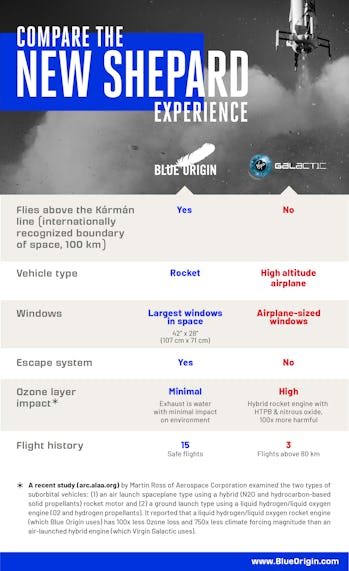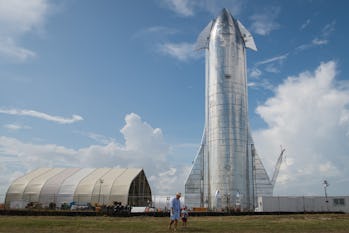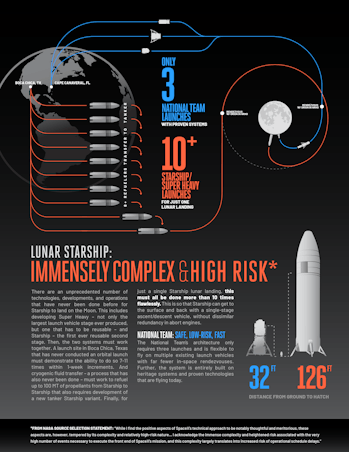Jeff Bezos still hasn't given up fighting for NASA's lunar lander contract.
By Sissi Cao • 08/06/21

Jeff Bezos speaks near part of an F-1 engine from a Saturn V rocket, on display in the APOLLO exhibit at the Museum of Flight, in Seattle, Washington on May 20, 2017. David Ryder for The Washington Post via Getty Images
In spring 2020, Jeff Bezos’ Blue Origin began an almost yearlong competition against Elon Musk’s SpaceX over a NASA contract to build a human-landing vehicle on the moon. The race ended in April with the agency selecting SpaceX as the sole contractor under its Human Landing Systems (HLS) program.
Refusing to take no for an answer, Bezos has been pushing back against NASA’s decision in every direction possible in the past three months.
See Also: Should Jeff Bezos and Elon Musk Pay for NASA’s 2024 Moon Mission?
Last week, the world’s richest man offered to waive up to $2 billion in future payments from NASA under existing Blue Origin contracts if the agency would award a separate lunar lander contract to his company.
“Blue Origin will bridge the HLS budgetary funding shortfall by waiving all payments in the current and next two government fiscal years,” Bezos wrote in an open letter dated July 26 to NASA Administrator Bill Nelson. “This offer provides time for government appropriation actions to catch up.”
Blue Origin also filed a complaint (along with another SpaceX competitor, Dynetics) with the U.S. Government Accountability Office, accusing NASA of violating its procurement strategy by selecting only one HLS contractor. The congressional watchdog denied Blue Origin’s protests on Friday, ruling that NASA had run a fair competition.
NASA originally intended to hire at least two private-sector companies to build the lunar landing system, but eventually decided to select only one contractor, citing cost as a primary factor. SpaceX’s bid was $2.9 billion, while Blue Origin’s was more than double at $5.99 billion.
To address the cost concern, Bezos said in his open letter that Blue Origin would accept “a fixed-priced contract for this work, cover any system development cost overruns, and shield NASA from partner cost escalation concerns” if NASA awarded a second contract.
Aviation policy experts say Bezos is motivated by a grand ambition to reign over the future space industry.
“Jeff Bezos, I believe, sees a vision where Amazon can control the future of the infrastructure of space,” said Bryan Del Monte, a former deputy director at the Department of Defense from 2003 to 2008. “If he can pull it off, he will be the richest man in history since Rockefeller. Because that’s what Rockefeller did—he effectively controlled the infrastructure of everything at his time.”
“Bezos believes that space is the railroads and highways of the future. That’s why he wants the control so badly,” Del Monte told Observer.
SpaceX plans to incorporate the lunar lander into its Starship launch system, which is gearing up for its first orbital test flight. Blue Origin plans to build a lander using some of the technology that flew Bezos and three other civilians to suborbital space last month.
Making a case for its own proposal, Blue Origin said SpaceX’s approach is “immensely complex and high-risk,” according to an infographic published on its website on Wednesday.
“There are an unprecedented number of technologies, developments, and operations that have never been done before for Starship to land on the Moon,” Blue Origin said on its website. “NASA ran a flawed acquisition and ignored the significant risks of a one provider model.”
Making technical comparisons, Blue Origin noted that SpaceX’s plan will require more than 10 Starship launches to land once on the moon and needs to be refueled in orbit, while Blue Origin’s lander “only requires three launches” and has “far fewer in-space rendezvous.”
GOT BEEF?
BLUE ORIGIN’S PETTY DRAMA WITH SPACEX EXPOSES ITS OWN GREATEST FLAW, EXPERTS SAY
Blue Origin published an infographic critical of the SpaceX lunar vehicle NASA chose over Blue Origin's Blue Moon lander.
WHAT’S NEXT FOR BLUE ORIGIN?
While infographics will not supersede a GAO ruling, Blue Origin is not out of the lunar landing game entirely.
The SpaceX contract only runs through the first crewed lunar landing mission, Artemis III, currently scheduled for October 2024. Meanwhile, in April, NASA called for proposals for lander vehicles to be used in routine lunar astronaut transportation, presumably for Artemis IV and beyond.
Bezos and Blue Origin might be making their case for the future, and specifically to Congress, according to Forczyk.
“Blue Origin is pretty much putting this out there to speak to Congress to say, ‘my competitor’s design is riskier than mine,” she says, “‘therefore you should have a second competition to have two providers in case my competitor is too risky and fails.”
Editor’s note, 8/6/21: A previous version of this article stated “Blue Origin has not yet launched anything to space.” This has been corrected to state “anything to orbit.”
MORE LIKE THIS
INNOVATION
8.4.2021 4:01 AM

SPACEX VS. BLUE ORIGIN: NASA MADE A HUGE INTERVENTION IN THE RACE
By MIKE BROWNSCIENCE
7.28.2021 1:01 PM

DOES THE EUROPA CLIPPER MISSION MEAN THE END FOR THE SLS?
By JON KELVEYINNOVATION
7.26.2021 12:00 PM

WHEN WILL ELON MUSK GO TO SPACE? SPACEX TIMELINE REVEALS VITAL DIFFERENCE TO BLUE ORIGIN
By MIKE BROWN
BLUE ORIGIN’S PETTY DRAMA WITH SPACEX EXPOSES ITS OWN GREATEST FLAW, EXPERTS SAY
Blue Origin published an infographic critical of the SpaceX lunar vehicle NASA chose over Blue Origin's Blue Moon lander.
BLUE ORIGIN MAY HAVE lost its appeal contesting NASA’s awarding rival SpaceX the contract to build a lunar lander vehicle. Still, Jeff Bezos’s space company is not taking the defeat lying down.
The space company published an infographic on its website Wednesday arguing that the SpaceX landing vehicle, a modified version of SpaceX’s Starship, is unproven and potentially unsafe for astronauts.
This is not the first time Blue Origin has taken a swing at another billionaire’s space company. The company tweeted a similar infographic on July 9 favorably comparing its New Shepherd vehicle to the SpaceShip Two of Virgin Galactic, owned by Richard Branson, and noting that Virgin’s vehicle does not fly above the Karman line, the internationally recognized boundary of outer space.

Blue Origin tweeted this chart favorably comparing the company’s New Shepherd vehicle to Virgin Galactic’s SpaceShip Two, on July 9. Blue Origin
But whatever the technical merit of Blue Origins' arguments in their new attack on SpaceX, it may be for nothing but spite, given that the Government Accountability Office rejected Blue Origins' appeal. SpaceX and Elon Musk now have the go-ahead to keep working on the lunar Starship for NASA’s Artemis program, which aims to return humans to the moon.
“There is no chance of SpaceX not proceeding with HLS for Artemis III,” Laura Seward Forczyk, founder of space consulting firm Astralytical, wrote in a tweet on Thursday. “NASA says it won. The GAO says it won. Attacking SpaceX only spreads negativity.”

Loren Elliott/Getty Images News/Getty Images
HERE’S THE BACKGROUND — “Lunar Starship: Immensely Complex and High Risk” is the large font headline of the Blue Origin infographic, which goes on to list the reasons the company believes NASA’s choosing SpaceX to build a lunar lander was a bad decision.
The Super Heavy booster plus Starship — Integral to SpaceX’s design is the reusable first stage booster to launch Starship, which functions as a second stage. If successfully developed, the pair will make up the largest-ever launch vehicle.
Boca Chica — SpaceX plans to launch the Lunar Starship from Boca Chica, in Texas, which has never hosted an orbital launch before.
Orbital refueling — For the massive Starship to reach higher orbits such as the moon, it will need to be refueled — a process known as cryogenic fluid transfer — with “up to 100 metric tons of propellants” from as-yet undeveloped tanker variants of the Starship vehicle.
Multiple launches per mission — Blue Origin argues that to provide the lunar Starship with enough fuel for a single lunar mission, SpaceX will need 10 or more launches from Earth.
And although not detailed in the text on the infographic, Blue Origin also includes a figure comparing the height of the lunar Starship and the Blue Origin’s Blue moon vehicle, noting it’s 32 feet from the vehicle’s hatch to the lunar surface and 126 feet for astronauts descending from Starship.

An infographic published by Blue Origin on Aug. 4 arguing that competitor SpaceX’s lunar landing vehicle is a riskier bet for NASA than Blue Origin’s own Blue Moon vehicle.Blue Origin
The infographic then promotes Blue Origin’s perceived advantages, notably that it can fly on a variety of launch vehicles and would require only three launches to assemble and fly to the moon. “Further,” the infographic reads, “the system is entirely built on heritage systems and proven technologies that are flying today.”
There’s not necessarily anything factually wrong with Blue Origin’s arguments, Forczyk tells Inverse, but “it was quite the argument to make when Blue Origin has not yet launched anything to orbit.” SpaceX, meanwhile, has flown cargo and astronauts to the International Space Station, has safely launched and recovered Starship from an altitude of 33,000 feet, and plans to make its first launch of Starship on the Super Heavy booster by the end of the year.
SpaceX’s plans are indeed risky, Forczyk says, but so are Blue Origins. “It is disingenuous to promote a competitor's design as risky when in fact, both of them are complex and risky,” she says. “Spaceflight is fairly risky.”
WHAT’S THE SOURCE OF BLUE ORIGIN’S BEEF?
In April, NASA awarded a single $2.9 billion contract to SpaceX to build the Human Landing System (HLS) component of the Artemis moon program, choosing the lunar Starship variant over Blue Origin’s Blue Moon and a third prototype developed by Dynetics. NASA’s source selection document noted that the SpaceX bid was the lowest of the three by a wide margin.
Blue Origin and Dynetics then filed a protest with the Government Accountability Office, leading to a pause in the HLS program until the GAO’s decision in favor of NASA on July 30. It’s a decision that ensures the first crewed lunar landing in more than 50 years will be made by a SpaceX vehicle, not a Blue Origin craft.
But the NASA source selection document also clarified that NASA would have liked to have made two awards and had two lander vehicles available, but did not due to lack of funds.
The space company published an infographic on its website Wednesday arguing that the SpaceX landing vehicle, a modified version of SpaceX’s Starship, is unproven and potentially unsafe for astronauts.
This is not the first time Blue Origin has taken a swing at another billionaire’s space company. The company tweeted a similar infographic on July 9 favorably comparing its New Shepherd vehicle to the SpaceShip Two of Virgin Galactic, owned by Richard Branson, and noting that Virgin’s vehicle does not fly above the Karman line, the internationally recognized boundary of outer space.

Blue Origin tweeted this chart favorably comparing the company’s New Shepherd vehicle to Virgin Galactic’s SpaceShip Two, on July 9. Blue Origin
But whatever the technical merit of Blue Origins' arguments in their new attack on SpaceX, it may be for nothing but spite, given that the Government Accountability Office rejected Blue Origins' appeal. SpaceX and Elon Musk now have the go-ahead to keep working on the lunar Starship for NASA’s Artemis program, which aims to return humans to the moon.
“There is no chance of SpaceX not proceeding with HLS for Artemis III,” Laura Seward Forczyk, founder of space consulting firm Astralytical, wrote in a tweet on Thursday. “NASA says it won. The GAO says it won. Attacking SpaceX only spreads negativity.”

Loren Elliott/Getty Images News/Getty Images
HERE’S THE BACKGROUND — “Lunar Starship: Immensely Complex and High Risk” is the large font headline of the Blue Origin infographic, which goes on to list the reasons the company believes NASA’s choosing SpaceX to build a lunar lander was a bad decision.
The Super Heavy booster plus Starship — Integral to SpaceX’s design is the reusable first stage booster to launch Starship, which functions as a second stage. If successfully developed, the pair will make up the largest-ever launch vehicle.
Boca Chica — SpaceX plans to launch the Lunar Starship from Boca Chica, in Texas, which has never hosted an orbital launch before.
Orbital refueling — For the massive Starship to reach higher orbits such as the moon, it will need to be refueled — a process known as cryogenic fluid transfer — with “up to 100 metric tons of propellants” from as-yet undeveloped tanker variants of the Starship vehicle.
Multiple launches per mission — Blue Origin argues that to provide the lunar Starship with enough fuel for a single lunar mission, SpaceX will need 10 or more launches from Earth.
And although not detailed in the text on the infographic, Blue Origin also includes a figure comparing the height of the lunar Starship and the Blue Origin’s Blue moon vehicle, noting it’s 32 feet from the vehicle’s hatch to the lunar surface and 126 feet for astronauts descending from Starship.

An infographic published by Blue Origin on Aug. 4 arguing that competitor SpaceX’s lunar landing vehicle is a riskier bet for NASA than Blue Origin’s own Blue Moon vehicle.Blue Origin
The infographic then promotes Blue Origin’s perceived advantages, notably that it can fly on a variety of launch vehicles and would require only three launches to assemble and fly to the moon. “Further,” the infographic reads, “the system is entirely built on heritage systems and proven technologies that are flying today.”
There’s not necessarily anything factually wrong with Blue Origin’s arguments, Forczyk tells Inverse, but “it was quite the argument to make when Blue Origin has not yet launched anything to orbit.” SpaceX, meanwhile, has flown cargo and astronauts to the International Space Station, has safely launched and recovered Starship from an altitude of 33,000 feet, and plans to make its first launch of Starship on the Super Heavy booster by the end of the year.
SpaceX’s plans are indeed risky, Forczyk says, but so are Blue Origins. “It is disingenuous to promote a competitor's design as risky when in fact, both of them are complex and risky,” she says. “Spaceflight is fairly risky.”
WHAT’S THE SOURCE OF BLUE ORIGIN’S BEEF?
In April, NASA awarded a single $2.9 billion contract to SpaceX to build the Human Landing System (HLS) component of the Artemis moon program, choosing the lunar Starship variant over Blue Origin’s Blue Moon and a third prototype developed by Dynetics. NASA’s source selection document noted that the SpaceX bid was the lowest of the three by a wide margin.
Blue Origin and Dynetics then filed a protest with the Government Accountability Office, leading to a pause in the HLS program until the GAO’s decision in favor of NASA on July 30. It’s a decision that ensures the first crewed lunar landing in more than 50 years will be made by a SpaceX vehicle, not a Blue Origin craft.
But the NASA source selection document also clarified that NASA would have liked to have made two awards and had two lander vehicles available, but did not due to lack of funds.
WHAT’S NEXT FOR BLUE ORIGIN?
While infographics will not supersede a GAO ruling, Blue Origin is not out of the lunar landing game entirely.
The SpaceX contract only runs through the first crewed lunar landing mission, Artemis III, currently scheduled for October 2024. Meanwhile, in April, NASA called for proposals for lander vehicles to be used in routine lunar astronaut transportation, presumably for Artemis IV and beyond.
Bezos and Blue Origin might be making their case for the future, and specifically to Congress, according to Forczyk.
“Blue Origin is pretty much putting this out there to speak to Congress to say, ‘my competitor’s design is riskier than mine,” she says, “‘therefore you should have a second competition to have two providers in case my competitor is too risky and fails.”
Editor’s note, 8/6/21: A previous version of this article stated “Blue Origin has not yet launched anything to space.” This has been corrected to state “anything to orbit.”
MORE LIKE THIS
INNOVATION
8.4.2021 4:01 AM

SPACEX VS. BLUE ORIGIN: NASA MADE A HUGE INTERVENTION IN THE RACE
By MIKE BROWNSCIENCE
7.28.2021 1:01 PM

DOES THE EUROPA CLIPPER MISSION MEAN THE END FOR THE SLS?
By JON KELVEYINNOVATION
7.26.2021 12:00 PM

WHEN WILL ELON MUSK GO TO SPACE? SPACEX TIMELINE REVEALS VITAL DIFFERENCE TO BLUE ORIGIN
By MIKE BROWN
No comments:
Post a Comment